For the past two months, much of the world has been in a state of lockdown, self-isolating because of the rapid spread of COVID-19. In the midst of all this, I have been wondering how I could reach out and help people find some comfort while they remain apart from friends, family, coworkers, and their normal daily lives. While it’s true that listicles of what to read in quarantine are abundant on the Internet right now, I thought I would try to share my own perspective with some themed lists of suggestions, especially since it seems like we’re all going to be keeping physical socializing to a minimum for a while yet.
My plan is to break the lists out into age groups and/or genres, in order to make them more easily digestible in one sitting. In my posts, I will be linking to Bookshop.org in case readers wish to buy the book in question. I also encourage readers to buy from their local independent comic or book shop if they don’t want to use my links, or to borrow from their local library. Many libraries are currently offering a more robust selection of ebooks, including graphic novels and comics, through Libby, Overdrive, and/or Hoopla. You can visit your library’s website for more information on how to access those apps, and I believe many libraries are also able to issue online-only library cards if you need one.
I know these times are challenging, and sometimes finding more tasks with which to occupy yourself can feel overwhelming. I don’t believe we should all be striving to be more productive right now; this virus has highlighted some major flaws in this country’s established operations, and it’s important to interrogate our need to be “useful.” But I do think that many of us, myself included, take comfort in books — and in this case, in comics. I hope that we are all able to find what we need right now, whether that be escapism, education, solidarity, or a call to action.
Above all, I hope we are all able to remain safe and healthy, and that we are able to return not to normal, but to an improved society that recognizes the importance of community and connection.
Happy reading!
The Series:
Reading With Little Ones
Middle Reader Mayhem
books
December Favorites
It wasn’t that long ago that I wrote up my favorite comics from November, but here we are already — the last day of 2019. It’s been quite the year for me, both in terms of my involvement with comics and in my personal life. A new year and a new decade is an exciting prospect! This will probably be my last monthly favorites post for a while, since next month I’ll be getting my bearings as a mother. As promised, I’ve been trying to slowly collect comics on pregnancy and motherhood, so I hope to write about that once I have some of my own experience with this new part of my identity! And I’m thinking of trying to combine some of my parenting experience with comic recommendations, but that might have to wait until my little one is out of infancy — we shall see!
But anyway, I’m jumping the gun a bit here. For this month, I’ve got a couple goodies that deserve some recognition!

Hell’s Paradise: Jigokuraku, Volume 1, by Yuji Kaku — published by VIZ Media
So far, I’ve only read the first volume of this series, despite the fact that it can be read chapter-by-chapter on the Shonen Jump website. A print copy is coming out in March, so I snagged an advance review copy — and I’m glad I noticed it, because otherwise I may not have thought to read this series! Ninja assassin Gabimaru has been sentenced to death for his crimes, but the stoic executioner Sagiri has been able to discern that he wants nothing more than to be reunited with his wife. She makes a deal with him: Gabimaru can go free if he finds the elusive Elixir of Life on behalf of the shogun. The Elixir is rumored to be on a mysterious island that keeps sending back every explorer as hardly human, blissful and with flowers growing out of their bodies. I enjoyed this first volume because it combines my interest in aesthetic violence/gore, my appreciation of a supposedly unfeeling character with an emotional weakness, and a complex female character who has to overcome her own insecurities as the story progresses. There are some seriously creepy monster designs even just in this initial book, so I’m looking forward to what this strange hell island has to offer going forward!

The Harrowing of Hell, by Evan Dahm — published by Iron Circus Comics, out March 10, 2020
It’s been a…hellish month, I guess! I don’t talk much about religion in general, but I was raised Catholic and even though I am not practicing, there are a lot of aspects of my religious upbringing that are still important to me. Chief among them is Jesus as a man, trying despite all the setbacks to preach radical peace. I follow creator Evan Dahm on Twitter, and I’ve been looking forward to his interpretation of Jesus’s descent into Hell for a long time now. The final product — or at least the advance copy I was able to get — is a gorgeous, black-white-and-red, ink-heavy, heart-heavy journey that was a pleasure to read. It spoke to me very directly as a lapsed Catholic, and as someone who appreciates seeing the humanity in Jesus more than the divinity. I think I’d like to read it again once it officially comes out to see what I’ve missed, because I suspect that the physical book will offer a more satisfying, tactile read than the digital galley. This is the second of Dahm’s works I’ve read, and I continue to be impressed by his ability to say so much with imagery. Also, I just really liked the little ribbon-like tails on the word bubbles in this volume. It was a sweet little detail that felt very special and carefully considered.
I suppose it seems odd to end the year/decade reading books about Hell or Hell-like places! It wasn’t really intentional, but these types of stories tend to be among my favorites. I’m hoping to read a lot of Jigokuraku while on my self-imposed maternity leave; in fact, I’m hoping to get a lot of reading done, in general, since I’ll have a lot of time where I’m sitting still holding/nursing a baby. Best laid plans of mice and Mo, of course — I feel as though I say I hope to read more every month.
There may be one more blog post in me after the New Year and before the baby arrives. But just in case there’s not, I hope everyone has a wonderful start to 2020, and that the year ahead brings lots and lots of manga to everyone!
September Favorites
I’m a little later than usual this month! September was a good month, full of lots and lots of writing work, visiting in-laws, and a trip to New Hampshire for some good New England-y early autumn fun. I continue to grow rounder with each passing day, and the baby has decided to set up a dance studio in my belly.
In manga-related news, I got to cover Skull-Face Bookseller Honda-san and The Way of the Househusband for Comics Beat this month. I did mini-reviews of them here last month, but you can read a more detailed review if you follow the links. I’ve also officially started as one of the hosts of Manga Machinations, and it’s been so much fun. It’s really rewarding to be able to have good, engaging conversations with people about manga. And knowing that others are interested in listening to those conversations and providing their perspective is awesome, too. Aaaaaaand Selling Comics came out! My name and my writing is in a real, printed book! It’s so cool, I’m still kind of in shock.
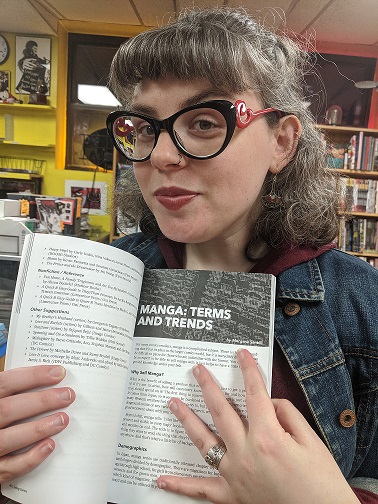
In terms of reading this month…unfortunately, a lot of it was for work or the podcast (and right now I’m reading a long-anticipated novel), so I only have one pick for you all. But it’s a real good one!
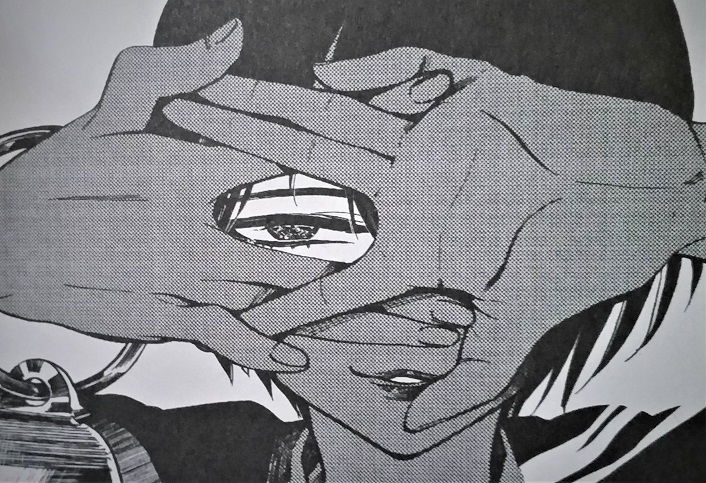
Phantom Tales of the Night, Volume 1, by Matsuri — published by Yen Press
Some of you may remember my love letter to Matsuri Akino’s Pet Shop of Horrors, one of my favorite manga of all time. My exposure to that series set in motion an obsession of mine; namely, the episodic morality play that utilizes an unreliable or amoral shop owner or service provider involved in the supernatural to mete out cosmic justice — or just sate his own desires — all wrapped up in a pretty, artistic package. Phantom Tales of the Night falls neatly into that description, with a mysterious innkeeper who trades protection, information, or a room for his clients’ secrets. And like every good nameless creepy innkeeper, his origins and history appear to be less than savory, though the first volume only gives us a glimpse at his arcane abilities. I’m such a sucker for stuff like this. It’s kind of pulpy, kind of queerbait-y, definitely pure, shameless entertainment. And while nothing will ever quite move me like the artwork in Pet Shop of Horrors, this series’s creator Matsuri (a different Matsuri!) has a lovely style that lends itself equally to beauty and body horror and weirdness. Again, totally my kind of manga.
And so, I end September and begin October on a decidedly spooky note. Historically, October has been an extremely busy time for me, and this year is no exception. I have volunteered to help with the Massachusetts Independent Comics Expo (MICE) this year, which is one of my absolute favorite local shows. If you’re around Boston the weekend of October 19-20, you should totally check it out and say hi! In between that, celebrating the season, and getting my normal work done, I’m going to try my best to read more. I’m hopefully going to also talk a bit about my horror manga recommendations! It’s something I always want to do but never quite get around to, and I’d really like to make the time to write about one of my favorite genres of manga.
Until then, happy reading!
August Favorites
I feel as though I start every one of these entries with “a lot has happened this month!” But yet, here I am feeling that sentiment all over again. With the last installment of our four-episode podcast series on Tokyo Tarareba Girls, the Manga Machinations podcast welcomed me on as a permanent host, starting in September. A couple weeks later, I announced my pregnancy to the Internet at large. And next week, CBLDF’s Selling Comics essay anthology is coming out, including a piece that I wrote.
I was able to see an advanced copy of Selling Comics recently and I was moved to tears — only partially because of the hormones. I saw my name listed among the names of so many comics retailers and other professionals for whom I have a great deal of respect and admiration, and I was honestly so honored to be among them in this wonderful collection. One of my favorite things to do is provide retailers with tools to sell manga, and it was awesome to have the opportunity to reach a wider audience — and to be featured in a print book! That’s so cool, y’all! I’m so excited.
Even with all this excitement, I managed to get quite a bit of reading in. Now that I’ve gotten into the swing of reviewing for Comics Beat, I am trying my best to stay a little ahead of the curve so I can write about manga close to their release date. This month, I reviewed one of my all-time favorite manga, Asumiko Nakamura’s Classmates, as well as the first volume of Akiko Higashimura’s Blank Canvas, in keeping with my brand of talking up Higashimura whenever and wherever I can.
I’m also looking forward to reading a lot more now that I’m a regular on Manga Machinations! The nice thing about reading in a group is that I’m going to have to branch out and read some things I normally wouldn’t consider. I’m expecting my monthly faves to start to change and evolve to include different, unexpected genres more frequently. But until then, here’s what moved me in August!

Skull-Face Bookseller Honda-San, Volume 1, by Honda — published by Yen Press
There was no way I was going to come away from this manga without loving every second of it. I had already seen a few episodes of the anime (which I fell behind on because I’m terrible at keeping up with anime) while I was still working at Comicopia, and I shared it with my coworkers at the time. Honda, depicted as a skeleton, works in the comics section of a large Japanese bookstore. Honda has to deal with all kinds of comics fans: Americans hunting for explicit doujinshi for their daughter, foreign BL fangirls, enthusiastic shonen manga otaku — you name it. The customer interactions are relatable enough, but it’s a lot of the nitty-gritty detail of working in book retail that really hit home. From dealing with reps and publicists, to stocking shelves, to having to adhere to street dates…it’s all too real for someone who has been in the trenches. I especially like the part where Honda admits to having difficulty carrying American comics, which are made on heavy, expensive paper and printed in color — and therefore are much, much heavier than manga. I’m also intrigued by the fact that I went into this manga assuming Honda was a man (and the anime gives Honda a masculine voice), but their gender isn’t ever stated, and there are hints that they might be a woman. Honda’s gender doesn’t particularly matter to the story, but I find it fascinating that I assume skeletons are men until told otherwise.
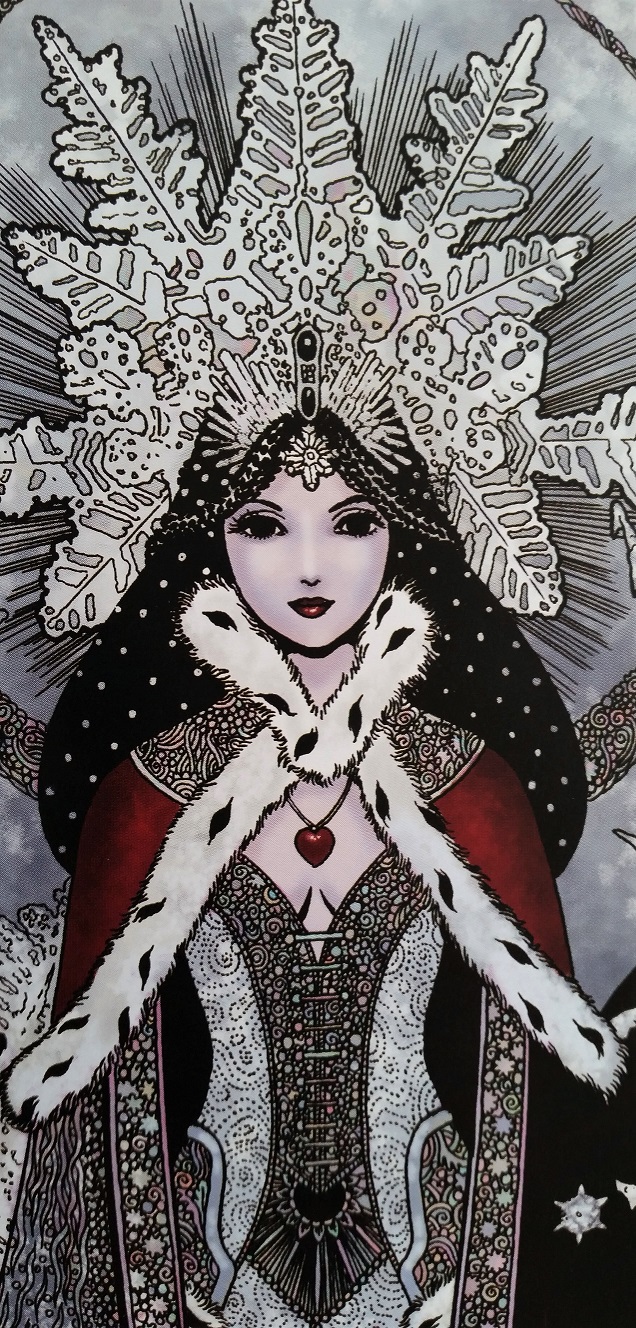
Snow, Glass, Apples, by Neil Gaiman & adapted by Colleen Doran — published by Dark Horse Comics
This short story by Neil Gaiman has always, always been my absolute favorite of his works, ever since I first read it in his Smoke & Mirrors collection. As a tween, I had an obsession with fairy tale retellings (I was the generation of Ella Enchanted, after all), and as I grew older I was also interested in darker themes in my fiction. And here comes Snow, Glass, Apples, weaving my inherent love for vampires and apple-related betrayals (I have a lot of feelings about the Garden of Eden, okay?) together with a story that places the traditional villain as the victim (I’m named after Morgan le Faye from Mists of Avalon…), and rendering me completely agog at its perfection. I didn’t think I could love it any more than I already did, but Colleen Doran’s adaptation is spectacular, utilizing a sublime influence from Harry Clarke’s illustrative works and steeping this horrifying tale in gorgeous lusciousness. My favorite kind of horror is always horror that is beautiful, and this adaptation is stunning from the lines to the colors and everything in-between. I cannot recommend it enough.
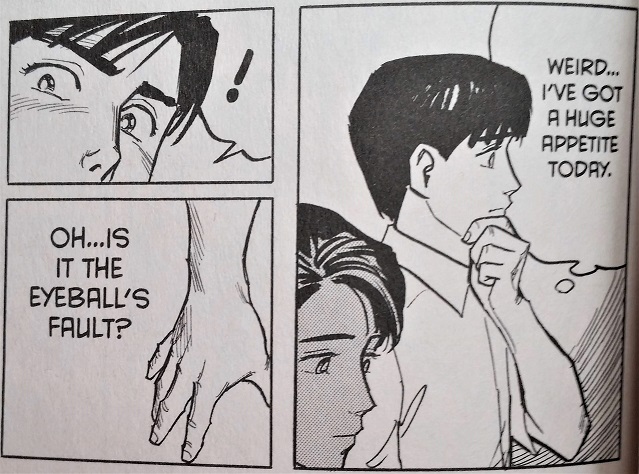
Parasyte, Volumes 1 & 2, by Hitoshi Iwaki — published by Kodansha Comics
I admittedly came to this manga really late! It was one of the early licenses that TokyoPop had back in the day, but I was too young to read or appreciate it back then. It’s one of those series where I kept thinking “I really should read this” but never got around to it — though I did watch the first few episodes of the recent anime (but again, I’m bad at keeping up with that stuff). And I am really, truly enjoying it a lot. I like well-done body horror — stuff that’s a little gruesome, but that has a point to it. I also am a sucker for intelligent entities sharing one body (thanks, Yu-Gi-Oh), as well as the struggle of main character Shinichi to determine what it is that makes him human — or what makes humans morally superior to other animals. It’s also really interesting to read about co-habitation of a body when I’m hosting my very own little parasite. Some of the things Shinichi is dealing with — a boundless appetite, new and strange emotions — are very similar to what I’m dealing with…though my baby is probably not an alien parasite bent on human destruction. I’m only two volumes in so far, but a friend of mine lent me the whole series so I’m gonna finish it all soon!

Way of the Househusband, Volume 1, by Kousuke Oono — published by VIZ Media
I was looking forward to this so much, and I was not disappointed in the least. I got an advanced copy of this and breezed through it. I…really, really love comedies about gangsters, whether they be high school hoodlums or members of the yakuza. In this manga, our protagonist Tatsu is a former yakuza boss who has left “the family” in order to concentrate on keeping house for his wife, a careerwoman working at a design firm. I love the dichotomy of Tatsu’s tough yakuza exterior with his apparently very serious dedication to wearing an adorable apron and making cutesy bento lunches for his wife. He seems to have taken all his yakuza training and applied it to being a househusband, and the results are an endearing and hilarious romp that just leaves you feeling good after you read it. This has its official release later in September, so be sure to preorder it or keep an eye out for it on bookstore shelves!

Komi Can’t Communicate, Volume 3, by Tomohito Oda — published by VIZ Media
I’ve actually been reading this series for a little while, starting with an advanced copy I got back in April or May. I thought the first volume was cute, but something about it compelled me to keep reading. And now, three volumes in, I’m just really enjoying it. The premise is a boy named Hitohito ends up sitting next to a girl in his class named Komi. Komi has a hard time communicating — and that’s actually an understatement. She doesn’t speak at all, but she is also beautiful and her silence leads classmates to believe she’s just a “cool beauty.” In reality, she’s an anxious mess, and somehow only Hitohito has picked up on this so far. He promises to be her friend, and to help her make 100 friends in high school. Watching Komi’s struggle with making friends is equally charming, relatable, and heartwarming, especially as her newfound friends find ways to help her overcome her communication disorder. This is another one of those simply fun manga, and I encourage anyone who feels the need for a little warm-hearted humor in their life to give it a go.
And with that, August is rapidly coming to a close. I’m always super busy in the fall, and my schedule has already started to ramp up. But I also love September and October, and as I gain baby weight I’m very much looking forward to cooler temperatures. If you’re local, you can find me paneling at LadiesCon on September 21st (some say hi!), and be sure to keep an ear on the Manga Machinations podcast starting first thing in September!
July Favorites
It’s been another bustling, busy month, but I made good on my promise and read more comics in July! I’m still more behind on my reading than I’d like to be, but it feels good to get back into some kind of routine (even if I have been doing all my work from our new couch instead of at my desk…).
At the top of the month, I started recording a four-part series with the wonderful gentlemen of the Manga Machinations podcast, a retrospective of Akiko Higashimura’s EISNER-AWARD WINNING Tokyo Tarareba Girls. Long-time readers and folks who follow me on Twitter will know that this is one of my absolute favorite modern series. I wrote about my feelings on the first volume ages ago, and those feelings have multiplied and intensified with each passing volume. By the time this post goes up, we’ll be three-quarters of the way through the retrospective. I hope that those of you who have had a chance to read the series will listen to our discussion of it and give us some feedback on your feelings about Higashimura’s love letter to 30-something women and the problems they face. It’s thrilling that I was able to talk about this series in the midst of its Eisner victory. Deb Aoki asked for some of my thoughts on the win and its potential affect on sales for her Answerman column over on Anime News Network, as well. I can’t reiterate enough how every manga fan should follow Deb on Twitter if they want all the latest news from cons and publishers. She’s a force of nature with her Tweeting skills!
I’ve also continued my work for The Comics Beat with reviews for Beastars volume 1, Junji Ito’s Smashed anthology, and the first two volumes of Satoko and Nada. Writing long-form manga reviews is my favorite job right now, hands down. It’s nice to be able to take the skills I utilized recommending manga to customers through working at Comicopia and translate that into recommending manga to readers all over the world. Since leaving the shop, I had been feeling a little isolated from the comics community, but writing for The Beat has helped me reaffirm my place within it and remind me that the work I do is worthwhile and (hopefully) helpful to readers.
So a lot is happening for me these days, and I’m hoping to have even more good news for you next month. But for now, it’s time to talk about what you all came to read — my favorite comics that I read in July. Some of these will likely be given the full Comics Beat review treatment in the near future, but I wanted to write about them a bit in a space where I can let my personal bias really shine through. :3

Popocomi, by various — published by Eriko Obayashi of Books and Gallery POPOTAME
I bought this wonderful anthology at TCAF and finally, finally sat down to read it. Organized by the Japanese comic shop POPOTAME, this collection features works by “underground” Japanese mangaka — something readers in the West rarely get to see. This collection runs the gamut from more straightforward short narratives to surreal or nonsensical offerings. It certainly won’t be everyone’s cup of tea, but I was really impressed with the variety and the skill on display. I was especially fond of Ikumi Nakada‘s melancholy “In a Worm-Eaten Town” and Maiko Dake‘s bubbly “FROM the BOOK SHOP.” They’re very different little glimpses into the lives of a couple of young women, but they both struck me with their ability to convey tone and emotion through the expressiveness (or lack thereof) of their characters. This collection was created in collaboration with TCAF and translated by the incomparable Jocelyne Allen, who has translated scores of my favorite books, provided interpretations for Junji Ito during TCAF, and who is a lot of fun to hang out with. The book was enthusiastically sold to me by one of the artists (whose name I unfortunately didn’t catch!), and came with a sweet little map of bookshops in Ikebukuro-Mejiro. The whole experience of buying and reading this book was unique, and it reminded me of the importance of connecting bookshops and artists with their products — something I believe in very strongly. Support your local bookstores! Support your local artists! Remember that a lot of love and care goes into putting together the works you love.
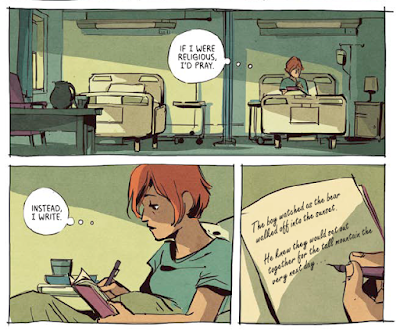
Waves, by Ingrid Chabbert & Carole Maurel — published by BOOM! Studios
I’m going to be completely honest — I sobbed through this book. The protagonist is pregnant, and the reader is made to believe this is not her first pregnancy, but that her other attempts thus far have failed. She and her wife are deeply invested in having a child, but because the protagonist’s condition is so tenuous, she is made to stay in the hospital. Unfortunately, things take a turn for the worst and the couple loses their precious son — stillborn. God, I’m starting to tear up just typing this! But the story is not just about losing the baby. It is about how that loss is used to help the protagonist push forward and find hope in a new career of writing books for children. This is an autobiographical comic with gorgeous illustrations by Carole Maurel that utilize color to great success. It’s definitely not a light read, but it is short and extremely affecting. I thought it was brilliant, even if I had to read a lot of it through blurred vision.
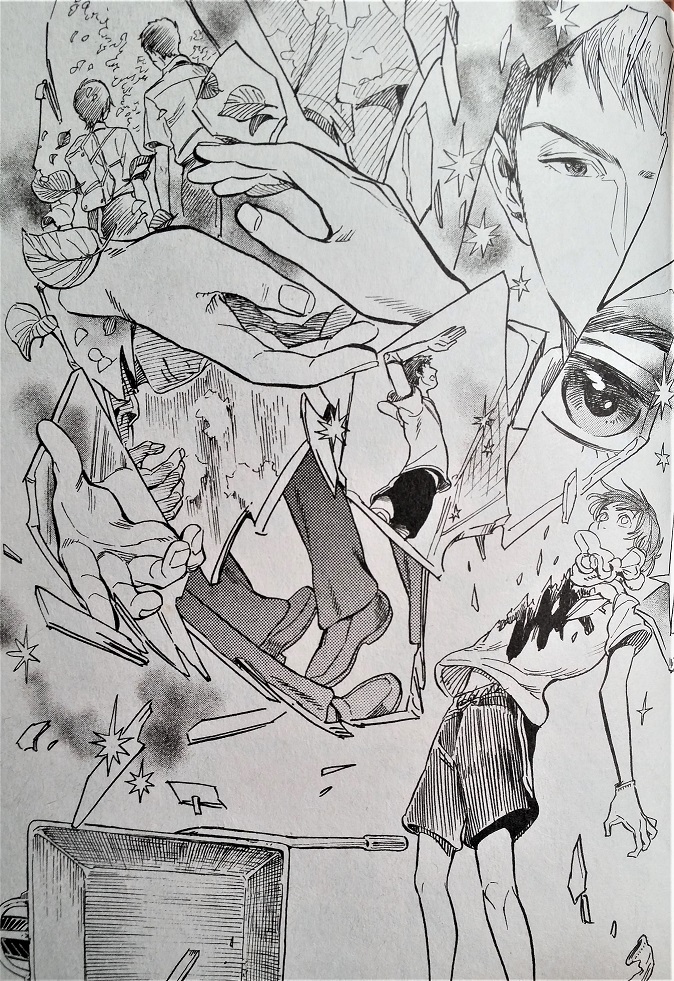
Our Dreams At Dusk, by Yuhki Kamatani — published by Seven Seas Entertainment
I have been SO excited for this release for so long, and I finally got my hands on a copy through the library. It is a little different from what I anticipated, but I’m not at all disappointed in it; rather, I think it’s great, and I can’t wait to check out the next volume which just recently came out. Protagonist Tasuku Kaname is struggling at school. Not with bad grades, but with being the new kid and being singled out for being gay. Of course, he didn’t tell anyone that he was gay, and he vehemently denies it, but the teasing comes anyway, to the point where Tasuku’s conflicting feelings nearly lead him to make a fatal decision. Luckily, he is distracted by a woman he sees in the distance who appears to be jumping to her death as well, and when he runs to see what became of her, he is confronted with her, whole and hale, and referred to by everyone in the drop-in center he found her in as “Someone-san.” Through this strange encounter, Tasuku meets others who are queer, and he is able to begin confronting his own fears about his sexuality and what it means for his life and his relationships. I find it deeply gratifying to have a fictional LGBTQ+ manga written by a non-binary creator and depicting a supportive queer network. A lot of the genuine queer works we’ve seen coming Stateside are autobiographical, and while their messages are so important, it is nice to see the field open up to fiction that isn’t relegated to BL or yuri — both of which are great in their own way, but which seldom reflect lived experiences or common concerns, especially amongst queer youth. Kamatani is know for their other manga series, Nabari no Ou, and I’m hoping that the name recognition might help get this manga into the hands of those who need it most — though my guess is that it’s already doing quite well based on the force of its subject matter alone. The importance of the story and characters aside, Kamatani’s artwork is gorgeous — fluid and expressive, with a boldness that I wasn’t expecting based on the dreamy cover designs.
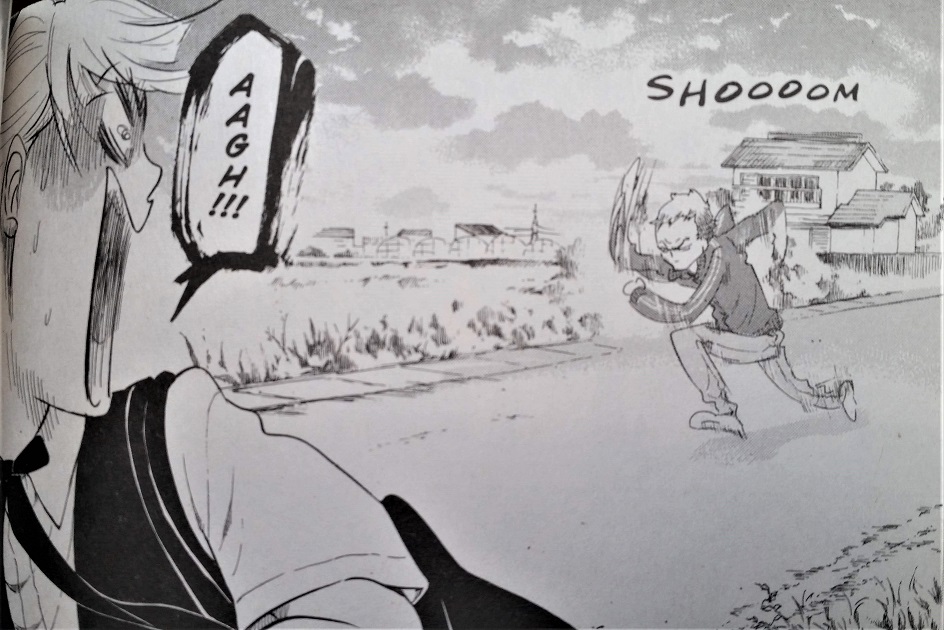
Blank Canvas, by Akiko Higashimura — published by Seven Seas Entertainment
This month I finished reading Tokyo Tarareba Girls and then immediately delved straight into Higashimura’s autobiographical work Blank Canvas, where she details her teenage experience of attending art classes outside of school to help boost her portfolio for college, and her relationship with an old, ornery art teacher who helped her improve immensely. I love Higashimura’s no-holds-barred, unflattering depiction of herself at that age: cocky, under-motivated, and underneath everything, deeply uncertain. This helps to shed new light on Higashimura’s many successes as a mangaka, reminding readers that while there might be something about her that is innately talented, it took years and years of work and drilling to become the master she is today. I could have used this manga as a self-assured teen, if only to light a fire under my butt to work harder at my dreams and to seek out the guidance I didn’t really think I needed. I’m still a little too cocksure sometimes, so it’s amazing to see someone I respect as much as Higashimura humble herself for her audience in this way. I’m not sure I’d have the same confidence if I were her, but she has absolutely, 100% earned it. And besides, she seems like the kind of teen it would have been fun to be friends with.

Classmates, by Asumiko Nakamura — published by Seven Seas Entertainment
There was a time, not too long ago, where I was very skeptical of Seven Seas’s output. They published a lot of works that were not for me in the extreme, with plenty of fanservice and an uncomfortable blurry line between what constituted age-appropriate content and what did not. And yet here I am today, promoting three of their recent manga with nothing but my highest accolades. At some point around the time they published My Lesbian Experience With Loneliness, Seven Seas took a deep dive into queer stories and have really set the standard for what types of manga readers are really scrambling for. Among those is one of my all-time favorite manga, Classmates. DMP had already owned this license, for digital distribution only, so I had read it a couple years back. I was struck then by a few things: the genuine sweetness of the story itself, and Asumiko Nakamura’s bizarre, stretchy, almost uncomfortable art style (which I adore). In my twenty-ish years of manga reading, I’ve read a lot of BL. A vast majority of it has been purely horny trash, stuff I didn’t particularly even like but felt compelled to read just to see if I could find the hidden gems. And the hidden gems are there, but you have to wade through scores of tropes: near-rape or rape scenes, coercion, incest, abuse, student-teacher relationships…basically, the tawdry, the inappropriate, and the obscene. But sometimes a manga like Classmates comes along — a sweet story about two teenage boys who fall in love and stumble through a predictable teenage relationship without too much meddling from the outside. And it’s a happy manga, one that brightens your day with its effortless charm and its delightfully wacky artwork. Nakamura’s long-limbed, long-lashed, almost alien-looking characters seem suited to eroguro works or philosophical stories — and she’s done things like that, too (I’m thinking specifically of Utsubora) — but somehow her distinct flair makes the characters’ expressions of amorousness, embarrassment, and teenage hilarity all the more effective. I’m so glad that this series has gotten the print treatment, and I hope that it draws in many, many new readers!
Phew! A really long one this month to make up for June’s scarcity. It’s nice to be back on a roll with reading — let’s hope I can keep it up for a while. Until next month, I wish you all happy reading!
May Favorites
As I’m writing this, I’m gearing to move out of my apartment and into a new, slightly bigger one (the better to accommodate my ever-increasing manga collection, right?), and I’m surrounded by boxes and boxes of my stuff. There’s nothing that makes you want to consider a life of asceticism quite like moving. May has been very much a transitional month for me, in more ways than just a change of address.
I already wrote a little bit about my adventures at TCAF. That sojourn sparked a lot of excitement and motivation within me, so hopefully I’ll be stepping up on my manga writing even more in the aftermath — gotta ride that wave of inspiration for as long as possible!
And something I haven’t mentioned yet is that I have contributed a short piece on manga basics to the upcoming CBLDF Presents Selling Comics: The Guide to Retailing and Best Practices in the Greatest Modern Art Form. I am so, so excited to have been asked to do this; about six years ago, CBLDF and Dark Horse collaborated on a similar book all about manga that featured writing from many intelligent, excellent writers whom I greatly admire. And since I have a lot of strong feelings about comics retail and selling manga in particular, this felt like an excellent first foray into comics print publication for me.
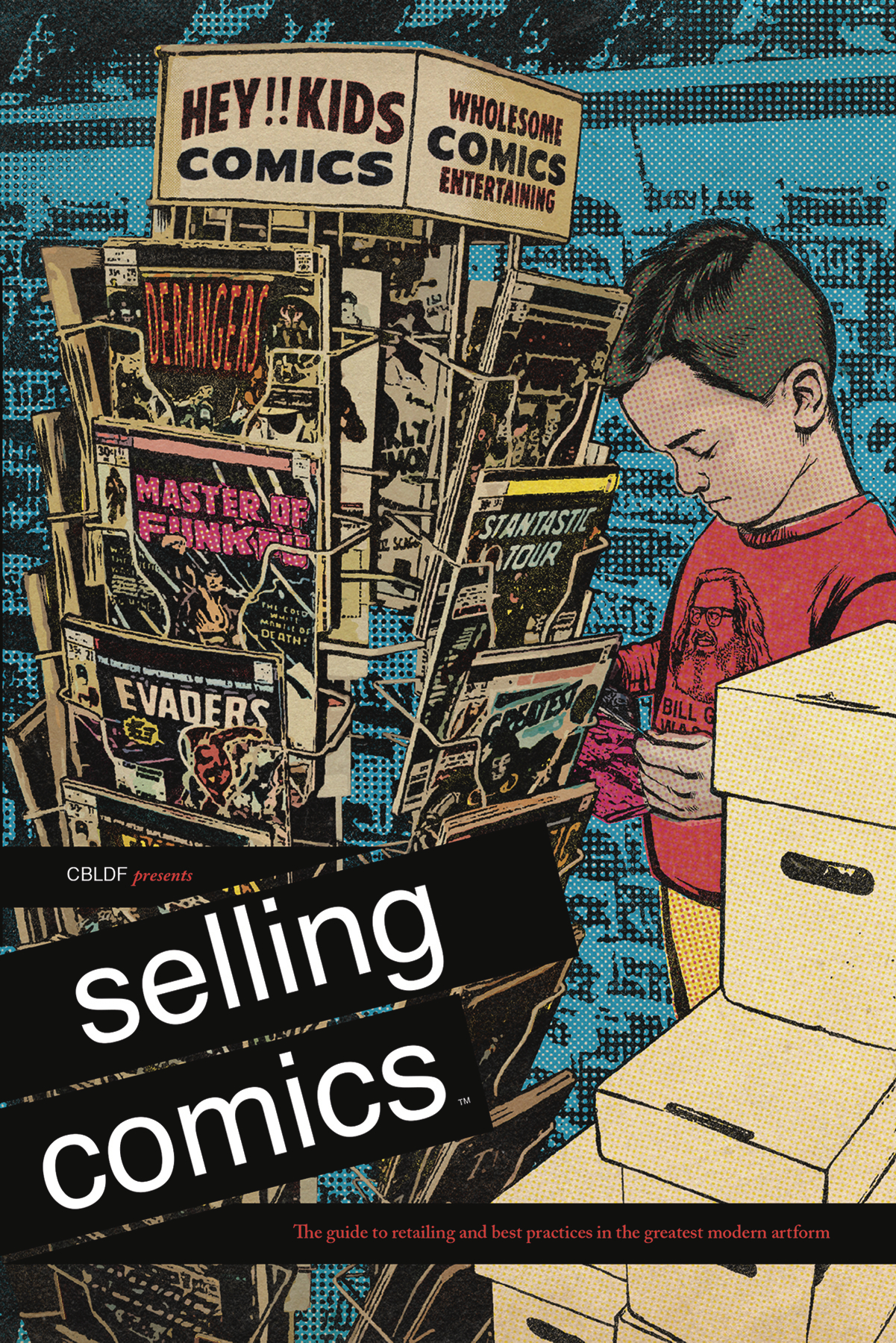
In between all the travel and writing, I did get a chance to read some really excellent books of all stripes. As usual, it’s time for me to highlight my favorite comics for the month!
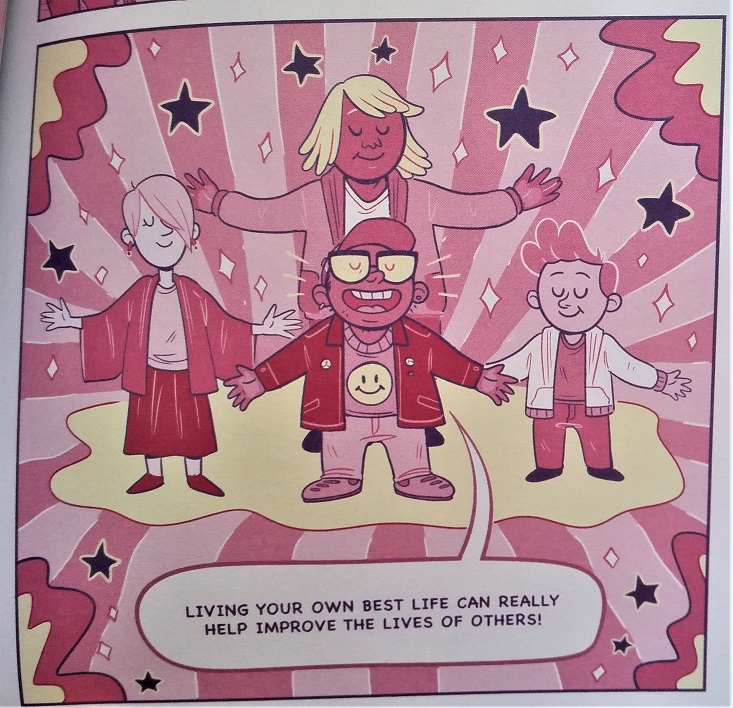
A Quick & Easy Guide to Queer & Trans Identities, by Mady G & J.R. Zuckerberg — published by Limerence Press
Last year, Oni Press’s Limerence imprint published A Quick & Easy Guide to They/Them Pronouns, which I thought was absolutely excellent, and I was gratified that we sold a ton of copies at Comicopia. With its friendly, non-judgmental tone and low price point, it was a really nice, gentle introduction to the topic of non-binary genders for people of all backgrounds. And so, I was very excited when Queer & Trans Identities was announced. It’s slightly less auto-biographical, but equally kind in its delivery with the added bonus of covering a lot of ground succinctly. There are two “stories” going on at the same time: A snail is teaching other snails all about different human identities and expressions, and a fantasy world populated by “sproutlings” shows the identity progression of one of its citizens. The artwork is adorable, bright, and fun, and the back matter encourages readers to create their own “sprout-sona” and design matching friendship jackets. I think what I enjoyed most about this guide was its dedication to inclusivity, and its patient guidance through myriad identities and sexualities — and a wonderful chapter on forging healthy, caring relationships that everyone, regardless of gender or sexuality, could use. I think this is a wonderful addendum to any coming-of-age talk that a parent or teacher might have with a young person, and it provides resources for further research as well. Growing up, I had to figure out my own ideas of gender and sexuality without the guidance of any adult queer person, and even though I have no real regrets or concerns about my own path, I think this is an endlessly valuable guide that I and my peers could have really benefited from.
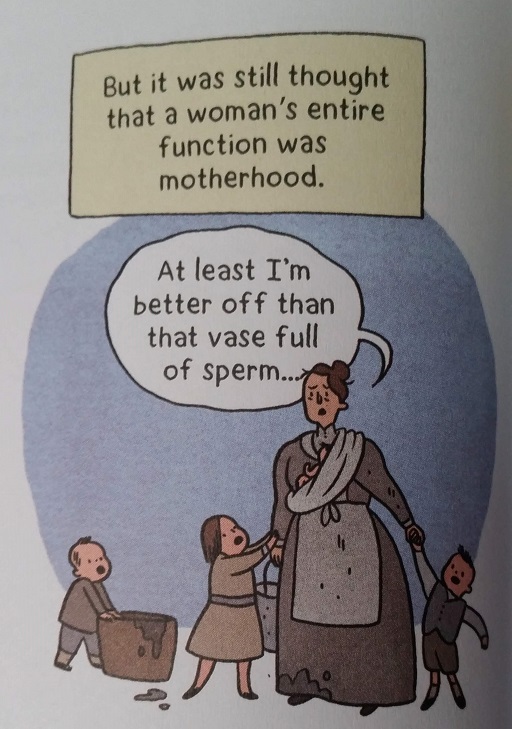
Kid Gloves: Nine Months of Careful Chaos, by Lucy Knisley — published by FirstSecond
It is a really, really scary time to be a person with a uterus in the United States right now. Abortion rights are being overturned state by state, causing people like me — even those of us who want to get pregnant and have children! — to worry about our autonomy and our value in the eyes of the law. So it was a really interesting time to decide to read Lucy Knisley’s autobiographical account of her very high-risk pregnancy — a book I had been patiently waiting to read since it came out, but scores of people already had on hold at my local library. This was actually the first of Knisley’s books I’ve ever read, though I do follow her avidly on Instagram, and it was worth the wait.
From the time most girls are born, there is an emphasis on them becoming mothers, whether intentionally or by accident. There is a lot of burden placed on girls and women to have babies and also to prevent them, lest they be marked “fast” or “easy.” But what I think doesn’t get talked about quite enough is how complicated and often dangerous pregnancy is — or how little control a pregnant person has over what happens to their body and their baby, in the grand scheme of things. So I appreciated Knisley’s openness about her two miscarriages, her extraordinary battle with constant morning sickness, and her concerns about pre-eclampsia that went unaddressed by her doctor. All these deeply personal and evocative anecdotes are peppered with chapters on the history of pregnancy and gynecological medicine, which is a personal interest of mine anyway (I love the Sawbones podcast!). And though she struggled so fiercely through her pregnancy, it is so clear how much she loves her son, how grateful she is for his presence in her life. This is an excellent read for our times, a good reminder that pregnancy and motherhood should never be forced upon a person, that it is a great risk and a great responsibility.
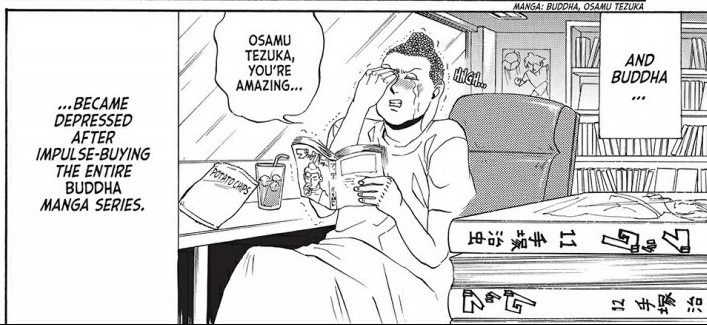
Saint Young Men, Volume 1, by Hikaru Nakamura — published by Kodansha (digital only)
I feel as though I’ve been waiting for this manga all my life. It’s commonly known that mangaka Hikaru Nakamura has been hesitant for Saint Young Men to have an English-language release, for fear that it might stir up some religious controversy. But as a proudly lapsed Catholic, I am ecstatic that it has finally made it Stateside. I am a huge fan of religious comedies; my favorite novel is Terry Pratchett and Neil Gaiman’s Good Omens, and Dogma is pretty high up on my list of favorite films. So the premise of Jesus Christ and Siddhartha Gautama kicking it in a tiny apartment in Japan just for fun is exactly in my wheelhouse. I appreciate anything that humanizes the figures that people worship, that allows common people to identify with these holy beings. I think that at the root of spirituality is the understanding that at our most basic, we are all connected to one another. And somehow, I think that comedy often conveys this idea better than any fire and brimstone sermon, catching us with our hearts and minds more open than they would be when we’re expecting to be lectured. Nakamura has a knack for finding the little things that elicit the big laughs — like how Jesus is so enamored of the fact that teenage girls think he looks like Johnny Depp, or how Buddha loves Osamu Tezuka (and especially Tezuka’s biography of Buddha himself). She’s also extremely adept at illustrating extreme expressions and inserting funny little tidbits, like the text on the T-shirts that Buddha screen-prints for the two of them. I really hope that this volume sees a lot of success so that maybe a print version will follow along soon!
It looks like I covered some heavy territory this month — gender identity, pregnancy and parenthood, and religion. But I was left with feelings of immense peace and gratitude after reading all these books, and I was able to reflect on my own ideas and beliefs without feeling judged or confused. It’s a rare thing, in our world today, to come away from hot-button issues feeling refreshed rather than completely exhausted and demoralized — and trust me, I’ve spent plenty of time there lately, as well. I always appreciate when reading can both be informative and act as a refuge, as a tool of empowerment to be wielded in my day-to-day life. We are very lucky to see these kinds of works being published, and I can’t wait to see what else we can look forward to in the future.
April Favorites
Every month, I get the itch to write this segment about halfway through, thus defeating the point of having a monthly round-up! I get too excited to talk about what I’ve just read, and I read a lot of good stuff in April.
Actually, a lot of stuff in general happened in April. I turned 29 on the 4th, so here’s to the last year of my 20s! My husband and I are in the midst of apartment hunting, which is always chaotic, especially here in the Boston area. And Anime Boston was last weekend! Even though I don’t technically work at Comicopia anymore, I helped with the ordering and was there on the floor from set up on Thursday to break down on Sunday. It was a really great show, and I’m glad I was able to be a part of it. Selling at conventions is my favorite kind of retail, because everyone is just so excited to be there and see what you’ve got and talk to you about it. And all the con-goers are so creative — I saw so many excellent costumes! Oh, and my very first post for Anime Feminist went up this week, as well: a spotlight on amazing artist and mangaka Junko Mizuno.
As May approaches, I’m getting ready to head over to the Toronto Comic Arts Festival (TCAF) for the first time, and I’m super excited. Between that and moving, May is going to be intense — but we’re not there yet. For now, I want to reflect on all the good stuff I read in April! And it’s actually all relatively new stuff this month, a sure change for me.
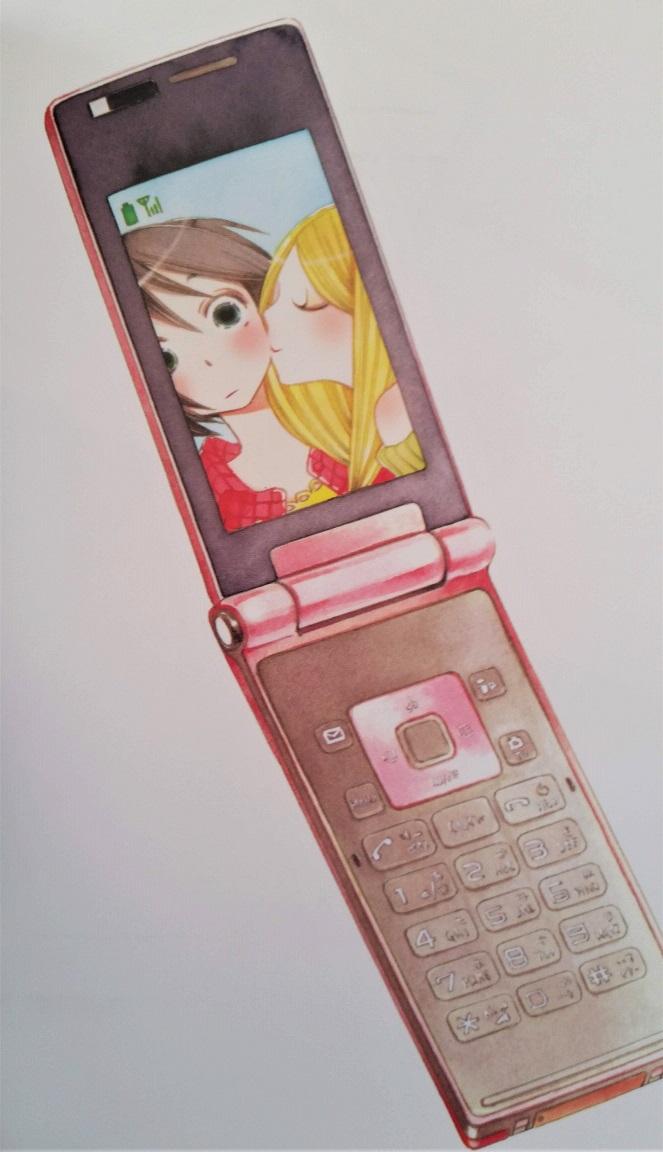
Maiden Railways, by Asumiko Nakamura — published by Denpa
This is the first of Denpa’s offerings that I’ve gotten a chance to read, and it’s the one I was most looking forward to. I love Asumiko Nakamura. Her art is so strange, both adorable and almost uncomfortable with all its sharp angles and long limbs. This volume is an anthology of railway-themed romances. It is simple and straightforward in many ways, but as with all of Nakamura’s work, it sets a very distinct tone, in this case of hope and longing and compassion. It’s a really lovely little collection with some lesbian themes neatly tucked into it with no fuss. Between this and Seven Seas’s upcoming print version of Classmates coming out soon, I am thrilled that more readers have access to Nakamura’s work.

Bloom, by Kevin Panetta and Savanna Ganucheau — published by FirstSecond
I had to wait for this book from the library for months, and I absolutely understand why — it’s absurdly charming. Ari’s dream is to move to the city with his band, but he can’t seem to escape his responsibilities at his family’s bakery. Hector, a culinary school student, has come to town to pack up his deceased grandmother’s home. Ari hires Hector to help in the bakery, in the hopes that by replacing himself, he will leave his parents no room to argue about his leaving home. But over the course of the summer, Ari and Hector grow close, and they have to make some big decisions about where their lives are headed, and whether those lives include each other. This book was so unbearably sweet, and so beautifully illustrated. Savanna Ganucheau does an excellent job of showing everyday examples of sexiness — nothing exploitative, but the little kinds of things that a person appreciates in their partner, like how they look when they’re focused, or how they move when they’re excited. With a cast diverse in both ethnic background and body type, and a strong, happy queer narrative, this is an incredibly delightful read for teens and up.
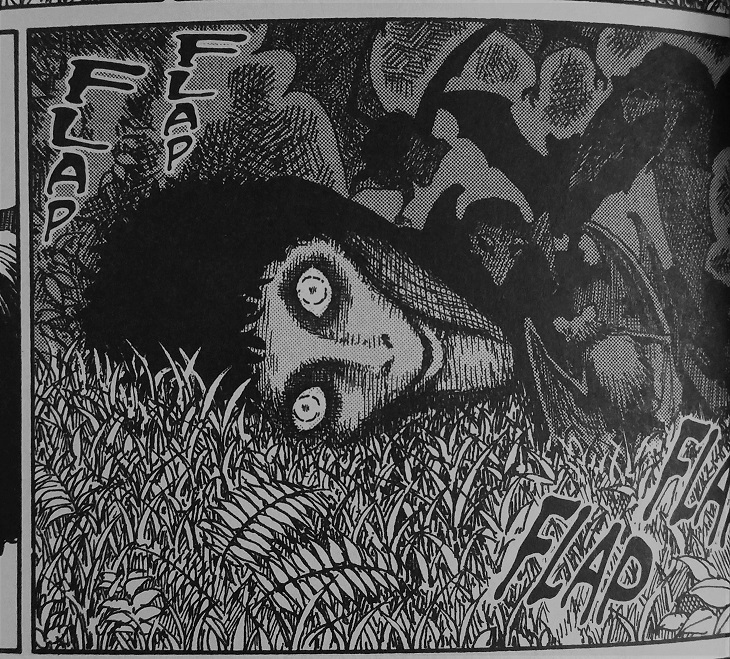
Smashed, by Junji Ito — published by VIZ Media
It’s no secret that I’m a HUGE Junji Ito fan. (That’s part of the reason I’m so excited about TCAF!) I never know what to expect with each new anthology: Will I be scared? Will I laugh? Will I feel like I just watched a particularly poignant episode of The Twilight Zone? For me, this collection had a lot of humor in it, and that is perhaps one of my favorite things about Ito’s work. There is a very fine line between comedy and horror, and no one loves to hop back and forth across that line as much as Ito. I think my favorites in this collection were “Bloodsucking Darkness” (because I love bats), “Soichi’s Beloved Pet” (because I love cats), and “Library Vision” (because I love books). The linked Soichi stories never fail to be silly fun, and as usual Ito’s artwork throughout the whole anthology is gorgeous and detailed. Truly, he is a master of horror, and all other kinds of base human emotions.
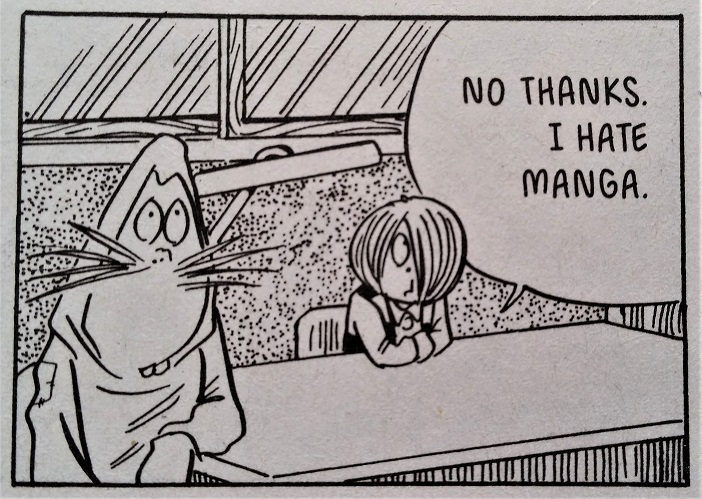
Kitaro’s Yokai Battles, by Shigeru Mizuki — published by Drawn & Quarterly
It’s been so long since there was another installment of Kitaro, and I was thrilled when I was alerted to this making its way into my pull at Comicopia. Who on this earth doesn’t love adorable, weird, childish monsters with potty humor? Only boring people, that’s who! In this collection, I was particularly fond of the “Oboro Guruma” chapter, in which Shigeru Mizuki has inserted himself as a major character, plagued by yokai who are taking over his home as their base of operations. As usual, Mizuki’s cartoony characters sit atop his lush and gorgeous backgrounds seamlessly, and the oft-times odd solutions to yokai-related problems harken back to simpler times and simpler story-telling mechanics. With each volume comes another installment of translator Zack Davisson’s “History of Kitaro,” which really appeals to my interest in both general world history and manga history specifically. A fun read suitable for just about anyone who appreciates a little dark whimsy in their life.
That’s going to do it for this month! I made the conscious decision not to include the sixth volume of Tokyo Tarareba Girls this time around, even though it’s one of my absolute favorite series, because I’ve already written about it in the past, and I anticipate I will talk at great length about it in many forms in the future. I thought I’d spare you all, haha.
I already have a huge pile of comics waiting to be read (don’t I always?), so hopefully I’ll have a nice round-up for May, as well. Happy reading!
March Favorites
It’s finally starting to feel like spring, and I couldn’t be more grateful. It’s so much easier to motivate myself to work when the sun is shining, especially after months and months of frigid winds and gray skies. March is always an odd month, sitting right at the edge of winter and spring, and it often makes me feel unsettled.
After over a month since my sweet kitty Mia’s passing, my husband and I decided we would start the process of looking for new feline companions, specifically hoping to adopt a bonded pair. We absolutely did not expect to adopt on the day we went to the local MSPCA shelter, but of course…the cats had other plans. On March 17th (Saint Gertrude’s Day, the patron saint of cats!), we brought home Zelda and Hilda, a mother-daughter pair of little black cats. They are charming in the extreme, so expect me to gush about them even more as time passes.
On the other end of the spectrum, I’m going to be having my wisdom teeth removed this coming Friday. It’s long overdue, and I’ll be glad once it’s done, but I’m definitely dreading what I’ve heard is a rather painful healing process. But who knows, maybe it’ll afford me more time to read….
Which brings me to the point of this post! Last month I did a round up of my favorite comics reads, and I’m going to go for it again. If I do it twice, it’s a monthly column, right? I actually didn’t read a ton of comics this month, instead favoring some truly indulgent murder mystery audiobooks. But of what I did read, there are a few certain gems that I want to share.
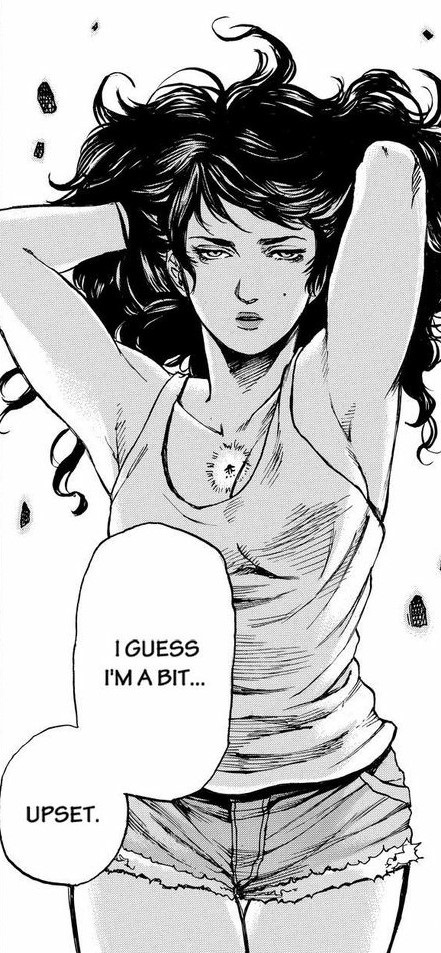
Star Light Woman, by Rie Kanou — available through Crunchyroll
At the start of the month, I decided to sift through the various reading-oriented apps on my tablet to find something new, and I came upon Star Light Woman on Crunchyroll. I was drawn by the image of protagonist Hoshi, rendered in what I think of as an 80s manga style, all puffy hair and cut-off shorts. I’m not sure what I was expecting — maybe a silly, slightly sexy sci-fi romp? And that’s more or less what it is, but somehow I really, really loved it. Hoshi just wants to lead a normal life, but she is the product of an experiment by an alien race to create the perfect weapon to save them from their enemies. She continually has to thwart these aliens while encountering other humans who have undergone similar transformations at their hands. It’s a short little series without much depth, but it’s truly funny and the artwork is stunning. I’m usually very critical of “sexy lady protagonist whose clothes don’t fit properly,” but Hoshi even gets my blood pumping, and I think that her strong, solid frame coupled with her highly moral principles lends a lot to her appeal. She’s like an embodiment of righteous female anger — a subject I’m always eager to see in my fiction!

Memoirs of Amorous Gentlemen, by Moyoco Anno — available through Crunchyroll
I love Moyoco Anno’s work, though I have to admit that this was only the second thing of hers I had ever read. Sakuran was a gorgeous and deeply provocative manga, so when I was scrolling through options on Crunchyroll’s manga app after finishing Star Light Woman, I remembered that I had been meaning to read Memoirs of Amorous Gentlemen for quite some time. I was not at all disappointed, and in fact I read Buffalo 5 Gals immediately afterward, just to get more of Anno’s sassy sex working heroines. But Amorous Gentlemen is special, probably my favorite of Anno’s works thus far. She is incredibly sensitive with sex work while also not over-glamorizing it; Colette and all her co-workers go about their day-to-day business like at any other job, and in many cases care very deeply about their clients. But they also are in close quarters, so they fight and disagree, and sometimes they are all too aware of how they are doomed to this life. The sex scenes are sometimes clinical and sometimes genuinely sexy, and I think that knowing when to evoke which mood in a reader is an incredible skill on Anno’s part. I’m also always going to be a sucker for her very stylized artwork, all angles and frills and fashion.
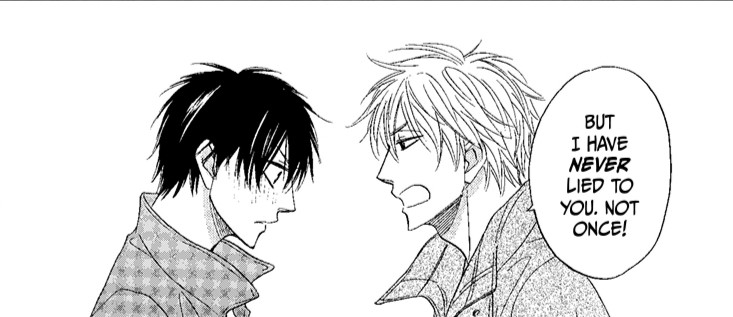
Candy Color Paradox, Volume 1, by Isaku Natsume — published by VIZ Media
The only manga on this month’s list that’s actually new this month, and the only one that has male protagonists! I was able to snag a galley copy of this right before it came out, and I honestly didn’t think it would be anything special. I’ll usually try to read new BL when it comes out, but I’ve been burned so many times with cliched plots or harmful tropes that it’s more a desire to keep up-to-date than an expectation that I’ll find something great. But VIZ’s SuBLime imprint has been knocking it out of the park lately, and I really liked this first volume. Protagonist Satoshi Onoe is a reporter who is proud of his body of work, but one day he is thrown onto a stakeout team with Motoharu Kaburagi, a photographer with a bad attitude whom Onoe believes stole his girlfriend away. The two start off on rough terms, but soon find that they work well together — and they begin to “catch feelings.” You know, that old gem. Honestly, it was cute and fluffy, and I feel like it’s been a long time since I read some straightforward “loathe to like to love” BL manga. The artwork is clean and appealing, with good sense of movement.

Nana, by Ai Yazawa — published by VIZ Media
This month, I decided to embark on a reread of Nana, and I’ve gotten up through volume 7 so far. I honestly don’t remember how much if it I’ve read in the past, so I wanted to make sure I got the full experience. I had watched the anime with my husband many years ago, and it wrecked us both, so coming back to it now, as a woman approaching my thirties instead of a woman barely out of her early 20s, is kind of a weird sensation. I’m farther away from any chance of making rash young adult decisions, but also in a place where I can envy the energy and passion that the characters portray as they lead a dramatic, punk-poverty-chic lifestyle. The series is old now, at least in the timeline of manga, so I don’t feel the need to summarize it, though I may one day write a whole piece about its meaningfulness to me, personally. I remember it didn’t sell great at Comicopia, but it was one of those series that I was adamant about keeping around. Yazawa’s artwork is so strange, with leggy, large-eyed Blythe-doll-esque characters and gorgeous renderings of haute couture of the 2000s, and I’m always enthralled by it. And I genuinely wish there was more work like Nana, work that explored the fraught relationships between female friends who love each other so passionately but don’t have the outlet to express it — an experience that will surely be familiar to many who squashed down their feelings throughout their teenage years for fear of judgment, or just because they didn’t have the tools to recognize those feelings. Society fucks women over, and Yazawa does an incredible job of balancing that message with a lot of genuine sensitivity for two very different women who are desperately reaching for an unobtainable happiness.
So, fluffy BL aside, it seems like I’ve read a bunch of manga about women who are dealing with too many external pressures getting in the way of their desires. That sounds like an appropriate way to have spent Women’s History Month! Honestly, though, my favorite works are often those by women representing the trials of womanhood — not because womanhood is terrible! But because it is cathartic to see your own worries magnified and projected in media sometimes, to see those fears getting played out somewhere safe, allowing you to recognize their validity but also release them in order to achieve your own goals, always knowing that you’re not alone.

The Beautiful & the Damned; Where Violence Meets Aesthetics in Pet Shop of Horrors
Among the extensive list of things I shamelessly love are: the occult detective genre, beautiful men, the monster-of-the-week format, and morality plays. Matsuri Akino’s Pet Shop of Horrors very neatly contains all of these things, and indeed might be the reason I’m so fond of some of them.
For those unfamiliar with this late-90s shojo series, the premise is that in LA’s Chinatown there is a mysterious pet shop whose proprietor, Count D, sells exotic “animals” to anyone who can pay the price. Each animal comes with a specific set of rules, and when those rules aren’t followed to the letter, tragedy inevitably occurs. LAPD officer Leon Orcot is assigned to investigate D and the weird phenomena linked to his shop, but in the process he is drawn into a series of Twilight Zone-esque situations that he cannot explain, let alone report to his superiors.
Right now, I can look at this premise and think to myself, “Yep, this is totally my kind of bullshit.” But when I first picked it up as a young teen, it was because I was drawn to its beautiful cover, where the androgynous D is holding a mermaid, whose back is turned to the viewer. D’s eyes are piercing and almost sad, his fingers long and delicate. I was in love with this man who moved in multiple worlds: the masculine and the feminine, reality and fantasy, beauty and horror.
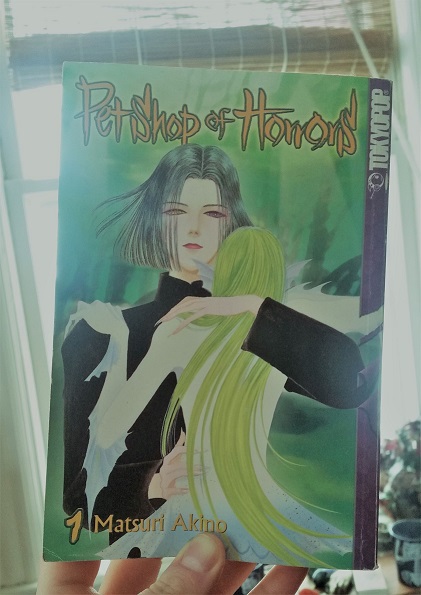
And when I bought and read this first volume, I was shocked. It wasn’t outright scary, necessarily, but it certainly was gory. In the first chapter already was there a horrific scene of evisceration, in and amongst all the trappings of a classic 90s shojo style, preoccupied with luxury and beauty. It was jarring, and it was effective. I discovered then that I didn’t dislike horror like I had previously thought, I just wanted it to be beautiful.
To this day, I find myself critical of scary or violent media that doesn’t also have a keen sense of aesthetics. I don’t necessarily enjoy being frightened; I am a naturally anxious person with vivid and violent dreams who does not react well to heightened suspense in media. I do like dark themes, though, and in recent years I have made it a point to expose myself to films especially that I know I would like if I could just get over my own hang-ups. And by being discerning, I’ve been rewarded with some of the most gorgeous horror and gore I’ve ever seen.
I think beauty and romance are natural companions to horror. All these themes pivot on an axis of drama, of amplified emotions. They all invoke visceral reactions, not logical ones. All my life I’ve surrounded myself with artwork depicting scenes and themes of witchcraft, hauntings, murders, martyrs, and mortality. It seems natural to me that scary things can pull at the same emotions I feel when I recognize something as beautiful.
And all this because way back in 2003, Tokyopop decided to take a chance on something that wasn’t very common in the comics world at the time: horror for girls. There’s plenty of it to be found in the manga world, and now there is more acknowledgement of girls and women reading outside of the romance genre. But it was new for me then, and even now Pet Shop of Horrors remains one of my favorite series, because it presented to me something I hadn’t known I was seeking out. It understood my tastes uniquely; it was able to marry my desire with my rage and prove them to be not disparate but intertwined and equally valid.
In truth, it is a somewhat silly series. It is certainly more fun than profound, but that in and of itself is not a criticism. It is pure, indulgent entertainment, and for me it is certainly laced with a nostalgic love that I will never be able to shake. How many times have I reread and referenced that first volume, gazing awestruck at the lovingly rendered intestines spilling out of a beautiful man’s body? How many times have I giggled at the flirtatious relationship between D and Orcot? How many times have I wished that modern depictions of mermaids were even half as scary as the one Akino has created?
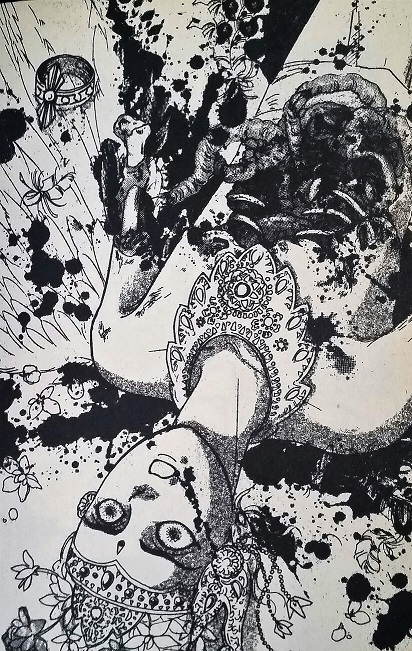
The series is unfortunately long out of print, and later volumes are hard to find. I imagine that it wasn’t a huge seller for Tokyopop, though I am forever grateful that they took a chance on it to begin with. The anime is available to stream on HiDive, brief as it is, if you’d like to get a glimpse into Count D’s enigmatic Chinatown pet shop.